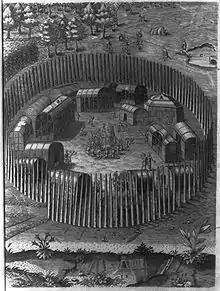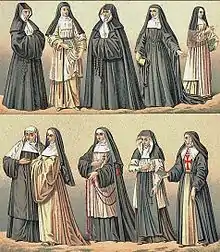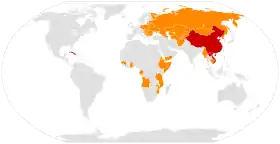Closed community
A closed community intentionally limits links with outsiders and outside communities. Closed communities may be of a religious, ethnic, or political nature. Governance of closed societies varies. Typically, members of closed communities are either born into the community or are accepted into it. The opposite of a closed community is an open community, which maintains social relations with external communities.[1][2]
Development

Frederic Clements was an American ecologist and pioneer who studied vegetation formation and development, he created the idea that plants are supposed to birth, grow/mature, and decay. Their life cycle is similar to that of a human being. Clements also tested a theory known as "climax community"; he used areas of vegetation in comparison to actual communities. The community (fauna or human) is always constant and thriving, even if there were to be a catastrophic event, an individual or small group can manage to survive and regrow or rebuild in the same area they originated or relocate else where and succeed. The concept of many plants and animals coexisting together, having an ecosystem and building upwards was the theory he aimed for (example: rain forest). The general theory later failed due to the fact that there was little or extremely basic comparable information about the logic of a being, the concept worked more in favor towards smaller organisms. Also, the theory became outdated and later on replaced with new sociological facts or science theories.[3][4]
Pros
- Security of residing in a controlled/supervised area
- Easier to find common interest, idea development with someone in your community
- Being able to finish work more efficiently, naturally, and more originally due to having no interference with exterior[5]
Cons
- Limitation and "cut-off" of diversity which leads to more difficulty accepting or incorporating outside concepts
- Constantly having the same people in a closed area within a large communities of 50 or more can cause a resident to feel overwhelmed with an urge to escape
- The fear of being overpowered or intimidation/competition
- Can close themselves so off from advancements that have a hard time reintegrating into society[6]
In a 1957 article published in the Southwestern Journal of Anthropology, archaeologist Eric R. Wolf argued that the organization of subsistence farmers into "closed, corporate communities" is a recurrent feature "in two world areas, widely separated by past history and geographical space: Mesoamerica and Central Java."[7]
Medicine in closed communities
Infectious disease presents particular challenges to closed communities; external action (from the government or outside medical personnel) may assist in stopping the spread of the disease.[8][9][10][11]
Religious and cultural communities

Some religious or ethnoreligious communities are considered closed. For example:
- The Amish are regarded as closed community; the Amish intentionally set themselves apart from the modern world).[12][13]
- Since the 11th century, the Druze have been a closed community.[14][15]
- Irish Travellers and Romani are more on the order of cultural closed communities.
Closed countries
Examples of closed countries

- Japan (formerly) – under the Sakoku policy of the Edo period, Japan secluded itself from Western influences, controlling contract.[16]
- North Korea - see also North Korean defectors.[17] Often regarded as the world's most secretive state.[18]
- Soviet Union - Soviet diplomat Anatoly Dobrynin wrote in his memoirs: "In the closed society of the Soviet Union, the Kremlin was afraid of emigration in general (irrespective of nationality or religion)" for fear of causing domestic instability.[19]
- See also Refusenik
- "closed cities" — secretive, specially controlled zones that contained nuclear reactors and other sensitive facilities continue to exist in Russia today.[20]
- Burma (Myanmar) - formerly a closed society and international pariah,[21][22][23] Burma underwent political reforms beginning in 2011 that made its society more open.[24][25]
- Eritrea - Human Rights Watch has described Eritrea as one of the world's most closed countries.[26] Eritrea has a closed, militarized, and heavily fortified border with Ethiopia, its regional rival with which tensions are high.[27][28]
Further reading
- "Anatomy: World's Most Isolated Countries". World Policy Journal 30.1 (2013): 22–23.
- Reiff, Joseph T. Born of Conviction: White Methodists and Mississippi's Closed Society. Oxford University Press, 2016.
- Erler, Mary Carpenter. Reading and Writing during the Dissolution: Monks, Friars, and Nuns 1530–1558. Cambridge University Press, 2013.
- Kinkead, Gwen. "Chinatown: A Portrait of a Closed Society. HarperCollins Publishers, 1992
- Gibney, Mark. Open Borders? Closed Societies?: The Ethical and Political Issues. Greenwood, 1988.
- Nakhimovsky, Isaac. The Closed Commercial State: Perpetual Peace and Commercial Society from Rousseau to Fichte. Princeton University Press ,2011.
- Symbol and Meaning Beyond the Closed Community: Essays in Mesoamerican Ideas (ed. Gary H. Gossen: University Press of Colorado, 1986.
- Gontier, Thierry. "Open and Closed Societies: Voegelin as Reader of Bergson." Politics, Religion & Ideology 16.1 (2015): 23–38. Web.
References
- http://www.aaai.org/ocs/index.php/ICWSM/09/paper/viewFile/228/571
- Wuthnow, Robert (2013-01-01). Small-Town America: Finding Community, Shaping the Future. Princeton University Press. ISBN 9780691157207. JSTOR j.ctt2854w2.
- http://www.esf.edu/efb/schulz/seminars/mcintosh.pdf
- "Frederic E. Clements". www.history.ucsb.edu. Archived from the original on 2012-10-01. Retrieved 2016-10-25.
- "Archived copy" (PDF). Archived from the original (PDF) on 2017-03-29. Retrieved 2016-11-01.CS1 maint: archived copy as title (link)
- "Should your online community be open or closed? | Online Community Results". Retrieved 2016-10-19.
- Wolf, Eric R. (Spring 1957). "Closed Corporate Peasant Communities in Mesoamerica and Central Java". Southwestern Journal of Anthropology. 13 (1): 1–18. doi:10.1086/soutjanth.13.1.3629154. ISSN 0038-4801.
- Kuzushima, Kiyotaka; Kudo, Toyoichiro; Kimura, Hiroshi; Kido, Shinji; Hanada, Naoki; Shibata, Motohiro; Nishikawa, Kazuo; Morishima, Tsuneo (1992-03-01). "Prophylactic Oral Acyclovir in Outbreaks of Primary Herpes Simplex Virus Type 1 Infection in a Closed Community". Pediatrics. 89 (3): 379–383. ISSN 0031-4005. PMID 1311067.
- Dagan, Ron; Gradstein, Serge; Belmaker, Ilana; Porat, Nurith; Siton, Yaffa; Weber, Gabriel; Janco, Jacob; Yagupsky, Pablo (2000-02-01). "An Outbreak of Streptococcus pneumoniae Serotype 1 in a Closed Community in Southern Israel". Clinical Infectious Diseases. 30 (2): 319–321. doi:10.1086/313645. ISSN 1058-4838. PMID 10671335.
- Gardner, P. S.; Cooper, Christine E. (1964-06-01). "The feeding of oral poliovirus vaccine to a closed community excreting faecal viruses". The Journal of Hygiene. 62 (2): 171–178. doi:10.1017/s0022172400039905. ISSN 0022-1724. PMC 2134602. PMID 14171269.
- Yagupsky, Pablo; Ben-Ami, Yael; Trefler, Ronit; Porat, Nurith (2016-02-01). "Outbreaks of Invasive Kingella kingae Infections in Closed Communities". The Journal of Pediatrics. 169: 135–139.e1. doi:10.1016/j.jpeds.2015.10.025. ISSN 1097-6833. PMID 26545728.
- Charles E. Hurst & David L. McConnell, An Amish Paradox: Diversity and Change in the World's Largest Amish Community (Johns Hopkins University Press, 2010), p. 253: "The Amish encourage a tight, closed community in which they are expected to marry other Amish, but doing so amplifies the potential for certain chronic inherited health problems, which is turn lead to great medical expenses and heavier economic burdens on the Amish community."
- Linda Dayer-Berenson, 'Cultural Competencies for Nurses: Impact on Health and Illness (Jones & Bartlett, 2007), p. 297: "The social organization of the Amish is guided by a desire to avoid assimilation and acculturation into dominant American culture ... a closed community like the Amish").
- Jerome Murphy-O'Connor, The Holy Land: An Oxford Archaeological Guide from Earliest Times to 1700, 5th ed. (Oxford University Press, 2008), p. 272.
- Farhad Daftary, The Isma'ilis: Their History and Doctrines, 2d ed. (Cambridge University Press, 2007), p. 189: "Henceforth, the Druzes became a closed community, permitting neither conversion nor apostasy."
- "The Seclusion of Japan". users.wfu.edu. Retrieved 2016-11-29.
- "Exposing North Korea - Photo Essays". TIME.com. Retrieved 2016-11-29.
- "North Korea exposed: Censorship in the world's most secretive state". Canadian Journalists for Free Expression. Retrieved 2016-11-29.
- Robert G. Kaufman, Henry M. Jackson: A Life in Politics (University of Washington Press, 2000, p. 282.
- Yegorov, Oleg (May 2, 2016). "A sheltered existence: Life in Russia's closed cities". Russia Beyond The Headlines.
- Burma: Prospects for a Democratic Future (ed. Robert I. Rotberg: Brookings Institution Press, 1998), p. 97.
- Tiniest of Openings in a Closed Society, Washington Post (May 18, 2002).
- Shanthi Kalathil & Taylor C. Boas, Open Networks, Closed Regimes: The Impact of the Internet on Authoritarian Rule (Carnegie Endowment for International Peace, 2003), p. 91.
- Inside Myanmar's transition from isolation to openness, PBS NewsHour (April 14, 2014).
- imeline: Reforms in Myanmar (July 8, 2015).
- World Report 2014: Eritrea, Human Rights Watch.
- Eritrea country profile, BBC News (October 30, 2017).
- Darko Janjevic, Eritrea accuses Ethiopia of border attack, AFP, Reuters, Associated Press (June 13, 2016).